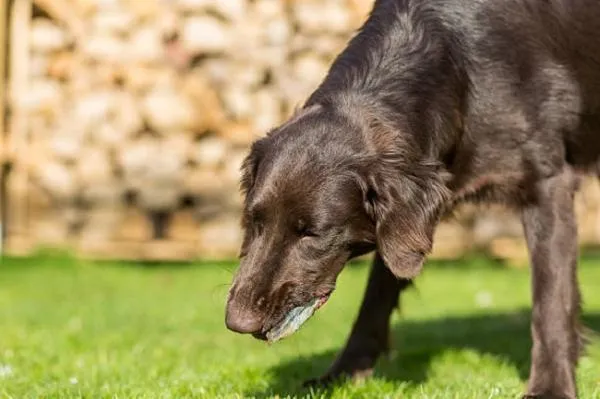
Activated carbon is one of the elements that should be part of our home first aid kit. Thus, activated carbon for dogs is used above all in the treatment of poisoning caused by different toxic substances. In addition, always following the veterinarian's criteria, it can also be administered in certain digestive disorders.

The charcoal that we are talking about here is the same that we get from burning wood or something else burned, like food, etc.
What is activated carbon?
Activated carbon is a product that is obtained from different materials, such as wood, almonds, coconut, palm trees, oil, peat or mineral carbon. It has different uses when it is part of filters, but the case that concerns us is that of activated carbon that is used in health problems that affect dogs.
Activated charcoal for dogs works by binding to toxic products, preventing their absorption by the body or, at least, reducing that absorption. Therefore, direct contact between the carbon and the toxicant is necessary. It has a very powerful absorbing effect, as it has a large surface area with which to bind other substances. A single gram of activated charcoal is capable of absorbing 100 to 1,000 mg of toxins. In addition, its use is very safe.
The effect will be greater or less depending on the characteristics of the substance ingested or even the content of the dog's stomach. It should also be borne in mind that it is more effective the sooner it is administered. In fact, if time has passed and the toxicant has been absorbed, offering the activated charcoal will no longer have benefits. Sometimes it is combined with other ingredients to add more effects on the digestive system.
What is activated charcoal for dogs?
First of all, activated charcoal can be used as a food supplement to protect the intestinal wall in case of indigestion or digestive discomfort. For this reason, activated charcoal can be used for dogs with gas, diarrhea and other gastrointestinal problems, always following the instructions of the veterinarian and as part of the treatment. These supplements often contain other ingredients.
Activated charcoal is also used to detoxify dogs, being one of the best ways to treat a poisoned dog. If we discover our dog ingesting a toxic substance, in some cases it is recommended to try to eliminate it as much as possible from the stomach. This is done by inducing vomiting. But first we always have to make sure that it is the most recommended action. To be sure, we'll call the vet.

When NOT to use activated charcoal for dogs
Do not induce vomiting if the dog:
- You have swallowed cleaning products or petroleum products.
- He has already vomited.
- He is not fully conscious.
- Has respiratory difficulties or neurological damage.
- The product label expressly states not to induce vomiting.
How to administer activated charcoal for dogs?
Once it is confirmed that vomiting is indicated, vomiting is triggered by administering hydrogen peroxide 3% solution. To do this, add a teaspoon of hydrogen peroxide to a glass of water for every 4.5 kg of the dog's weight. The same dose can be given up to a maximum of three times at intervals of 15-20 minutes while we move to the veterinary center.
After vomiting, and only when the vomiting has ended, is when it is recommended to administer activated charcoal for intoxicated dogs. Of course, supplying it does not replace a visit to the veterinary center. The professional must assess the animal, stabilize it and continue decontamination. In addition, activated carbon is usually combined with so-called cathartics or laxatives, which favor the evacuation and consequent elimination of the toxin through the faeces. In other words, they increase the speed of transit of the substance through the digestive tract, so there is less time for the body to absorb it.
Activated Charcoal Dosage for Dogs
Activated charcoal can be found in 5.5mg tablets, making it easy to administer at home. The dose, in cases of ingestion of a toxic substance, is one tablet for every 5 kg of weight of the dog. You can also find activated charcoal in liquid or powder to dilute in water, but it is more complicated to give it to the dog through a syringe. They have a dense and viscous consistency that can cause rejection in some dogs, hence the difficulty of getting them to swallow it. Others do ingest it without problem, but care should be taken so that an aspiration does not occur that ends up with the product in the respiratory system. The vet can also administer the activated charcoal through a gastric tube. In addition, if activated charcoal is prescribed for digestive problems, it is this professional who will have to adjust the dose and the administration schedule.
Side Effects of Activated Charcoal for Dogs
It is not very common, as it is not absorbed or metabolized, but the administration of activated charcoal can cause adverse effects in some dogs. We must be attentive to signs such as the following:
- lack of coordination
- Alterations at the mental level.
- Tremors.
- Panting.
- seizures
- In the most severe cases, the dog goes into a coma.
If we detect any of these signs, we must immediately inform the veterinarian. By the way, after the administration of activated charcoal it is normal for the evacuated stool to be black, so we should not worry.
I hope you liked my HiveBlog friends.